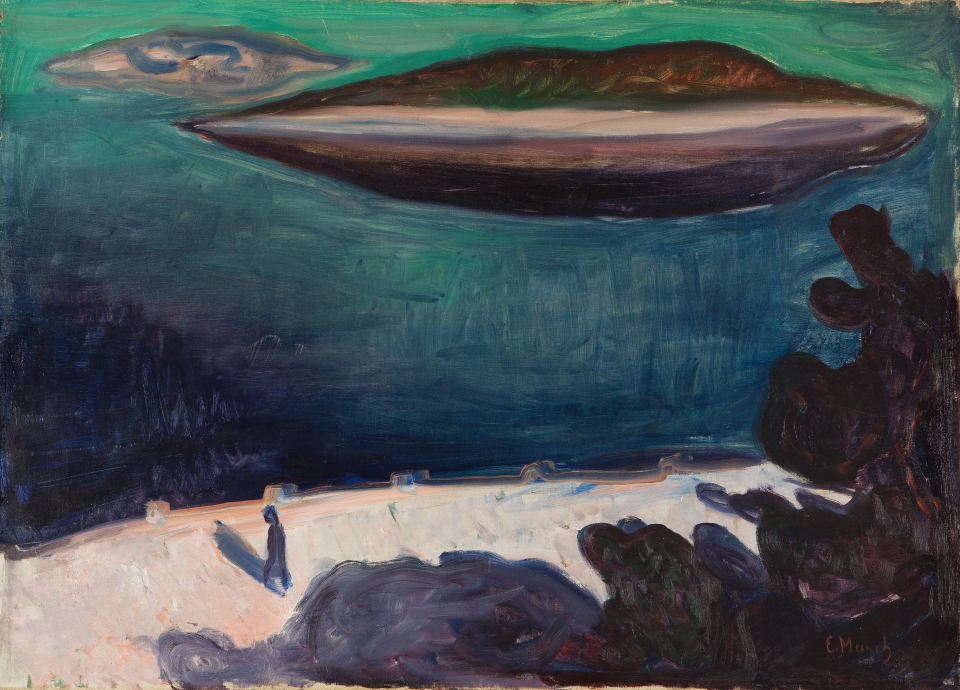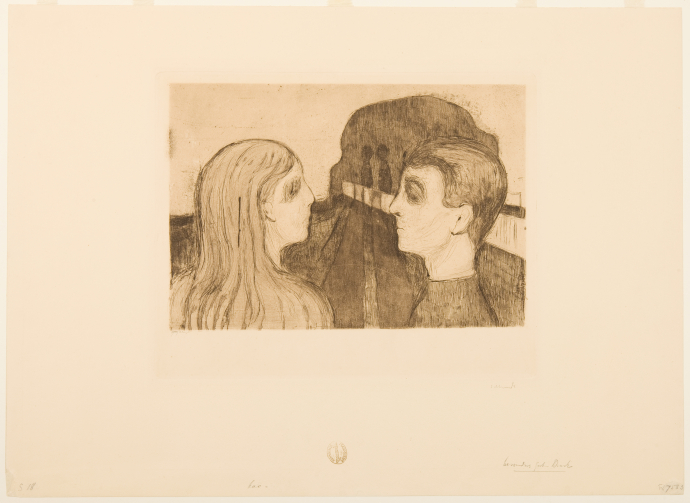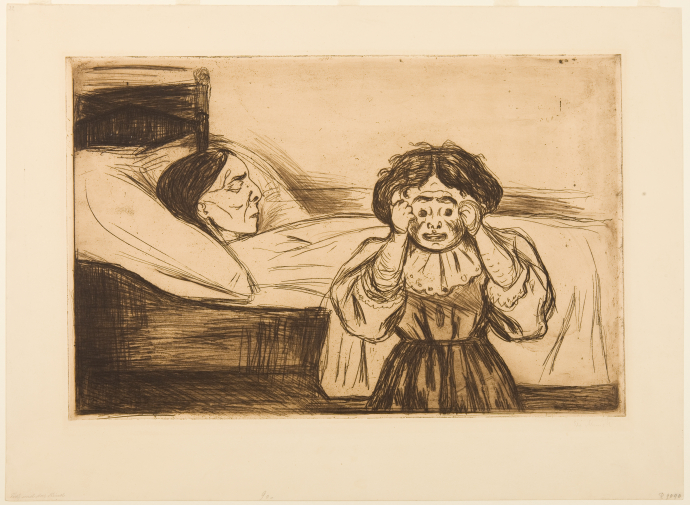Utsikt fra Nordstrand
Nicht ausgestellt
Intro
A single glance at this painting of the Oslofjord in Norway is all it takes to realize that Edvard Munch is more concerned with an emotional experience than a faithful representation of nature. Two clearly defined islands can be seen on the surface of the water, which he has captured in cool blue and green tones. Their compact form, but also the two-dimensional quality of the water, generate the impression that the islands are floating above the fjord. In contrast, at the bottom edge of the painting, Munch disrupts the arrangement of deep blue color with the bright pink and white tones of the road running alongside the fjord.
The light illuminating the scene indicates a bright Nordic summer night, in which a solitary walker casts his long shadow onto the fjordside road. The figure is himself shadowlike, his isolation intensified by the cool fjord landscape. In contrast, the dark forms in the bottom right corner of the picture—half plant and half rock—intrude eerily into the pictorial space and in the direction of the walker, creating a menacing atmosphere.
Background
The collection of the Kunsthalle Mannheim also contains a painting by the great Scandinavian artist Edvard Munch: »View from Nordstrand«. The chosen subject focuses on the representation of nature, so that it is only at second glance that the work, created around 1900, demonstrates Munch’s masterly rendition of the human psyche. Painted in predominantly cold shades of blue, the landscape depicts a view from the mainland of the island world of the Norwegian artist’s homeland. From an elevated position, the viewer’s gaze is directed over a group of trees and the adjacent coastal promenade to the tranquil water surface of a fjord. In the top third of the picture, two islands near the coast interrupt the expanse of deep blue to turquoise sea. Through the reflection of the outlines, their mountainous forms appear double. Within the natural setting, recorded with rapid brushstrokes, the male figure at the bottom left appears extremely small, accompanied only by his elongated shadow on the brightly lit coastal road.
Munch found his model for the painting, originally titled »Wolf Island Seen from Nordstrand« and later also known as »Summer Night on the Oslofjord«, in Nordstrand, south of Kristiania, the present-day Oslo. The artist lived for short periods on a number of occasions between 1893 and 1900 in the small seaside village. Numerous landscapes from the immediate vicinity of the fishing village, which nowadays has long been part of the Norwegian capital, reveal the artist’s intensive study of the untamed beauty of Scandinavia. In all these representations of nature around Nordstrand, Munch never intended to create a realistic reproduction of what he had seen. The scenery, which is committed to canvas by means of a few patches of colour, was intended to be seen primarily as a conveyer of moods and feelings, which the artist experienced directly while painting the picture. Against this background, it seems logical to equate the lonely rambler with the artist himself. For this, however, there is no reliable proof – nor is it possible to confirm the interpretation of the larger island as the closed lips of a female mouth.
Kunsthalle Mannheim
Transkription
The sky is a glowing neon green. From the bluish-green waters, two brown islands with pink beaches emerge. The front one is mirrored in violet-black shades in the water. A bright, salmon-colored coastal road extends across the lower third of the canvas, where a lonely figure is walking towards the water. Black treetops or cliffs are casting violet shadows streaked with white. They appear to be grasping at the walker.
There’s a strange atmosphere in this „View from Nordstrand “ captured by Edvard Munch from 1900 to 1901. Is it noon? Or rather dusk? None of these: Aged 40, the Norwegian painter was on the brink of international recognition when he captured the lighting of a Nordic summer night in flowing patches of color on his 71.5 by 100 cm canvas.
The scenery feels unreal, even menacing. Through their mirror image, the islands seem almost detached from the water. The basic mood ishallucinatory. The foremost island is reminiscent of a pair of lips: is this landscape supposed to be a blueprint of the erotically charged feelings of its creator?
Munch himself interprets his landscapes as resonating cavities for psychic processes: „I cannot finish my work until I get this vision at arm’s length, so that memory will concentrate my impressions – Nature tends to confuse me if I am directly confronted with it.“
This confusion is exactly what the artist wants to convey to the viewer in „View from Nordstrand“: the horizon line is dispensed with, rendering any optic orientation in the painting impossible. The outlines of the island reflected in the water are blurred. The result is a bizarre depth perspective: when looking at the spatial relationship of the colors, the light green sky seems closer than the deep blue water. The sky pushes towards the foreground, bending the image space. Consequently, the image background becomes instable, evoking feelings of insecurity and unease.




